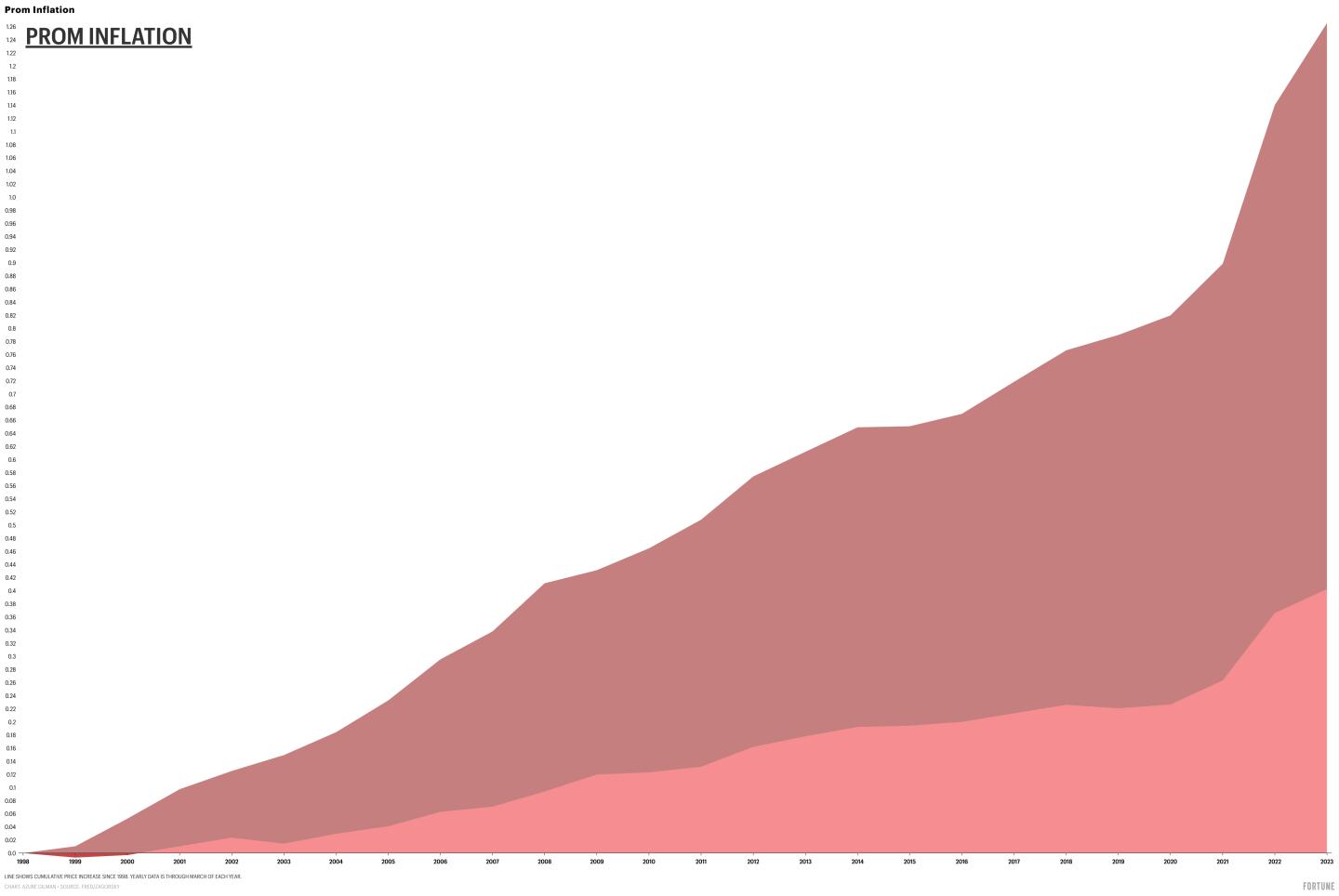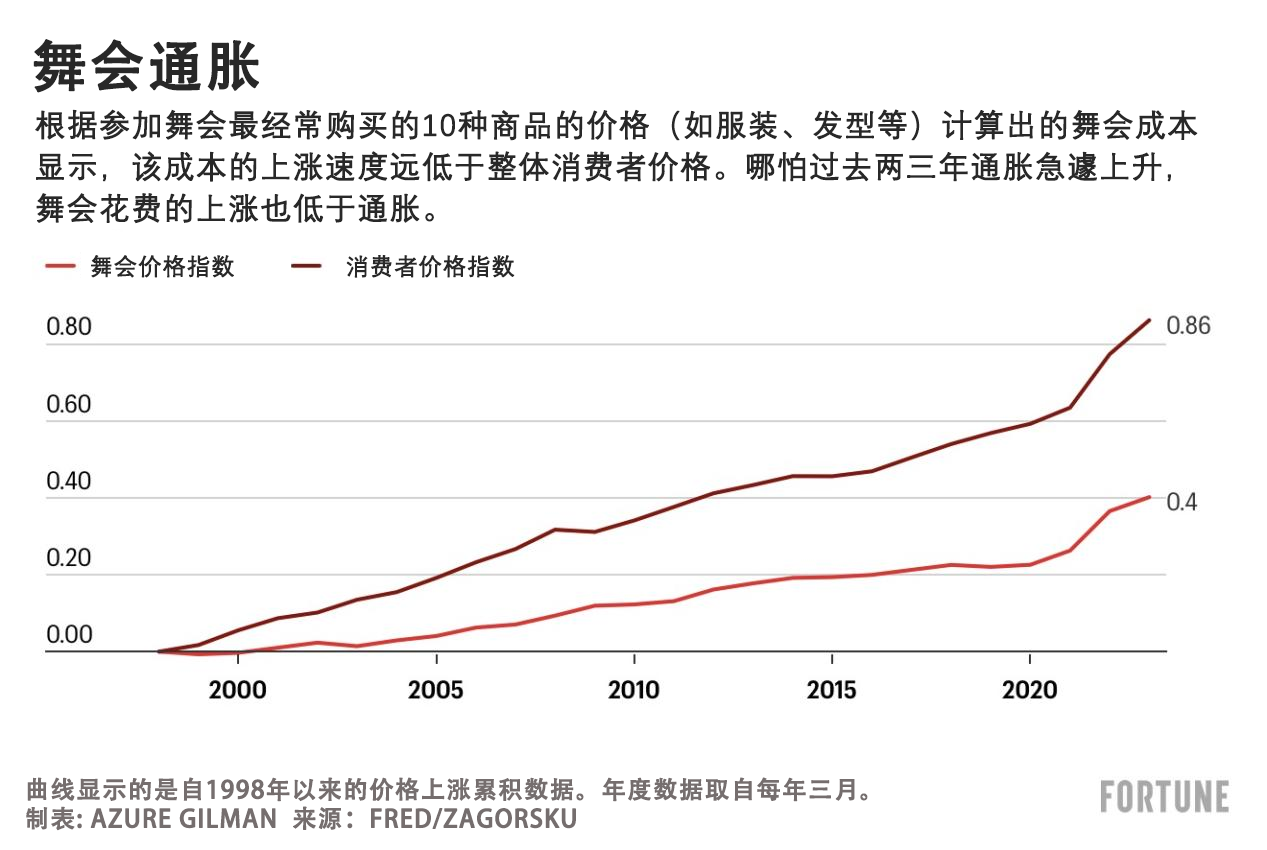
對于囊中羞澀的青少年來說,參加畢業(yè)舞會可能是一件挺費錢的事情。以往的評估和調(diào)查顯示,參加畢業(yè)舞會的平均花費從600美元到1,000美元不等,甚至更多。據(jù)稱,一些青少年在高中畢業(yè)時為這項傳統(tǒng)的舞蹈儀式花的錢超過2,000美元,這還不包括沒有必要的舞會后派對。
過去一年,通貨膨脹率已經(jīng)達到了自20世紀(jì)80年代以來的最高水平,舞會的花銷是否也水漲船高呢?
作為一名經(jīng)濟學(xué)家,我從2014年開始就對畢業(yè)舞會的成本感到好奇,因為當(dāng)時我女兒參加了她的舞會。在算完這個成長儀式花了我多少錢之后,我開始追蹤這些花費。我的發(fā)現(xiàn)讓我意想不到,但可能會讓每一名給孩子花錢參加這個大日子的父母感到高興。
幾百年的傳統(tǒng)
畢業(yè)舞會的傳統(tǒng)至少從19世紀(jì)末就開始了,已經(jīng)成為一種標(biāo)志性的高中體驗。
在百老匯的戲劇和電影中,無論是恐怖片還是喜劇片,都出現(xiàn)過畢業(yè)舞會的場景。畢業(yè)舞會的傳統(tǒng)也在發(fā)生變化,出現(xiàn)了一些新花樣,比如不去約會,或者不穿傳統(tǒng)服飾。
考慮到購買禮服、租用燕尾服甚至門票本身的高昂價格,市面上出現(xiàn)了各種介紹舞會省錢小巧思的文章。
雖然從社會和文化視角看這個議題十分有趣,但我的專業(yè)素養(yǎng)讓我考慮的更多的是金融和經(jīng)濟的角度。
從根本上說,當(dāng)舞會的成本下降時,就有更多的青少年去得起,它就變成了一種更加開放的共同體驗。而當(dāng)價格上漲時,舞會就變成了一種更排外的社交活動,參加的主要是父母更有錢的孩子,從而導(dǎo)致共同經(jīng)歷減少。高昂的費用是只有大約一半美國人參加畢業(yè)舞會的原因之一。
即使對那些與高中經(jīng)歷沒有直接關(guān)系的人而言,舞會的價格也很重要。美國是不同文化、宗教和種族的大熔爐。將這些不同的群體連結(jié)在一起的是各種共同的經(jīng)歷,例如慶祝美國獨立紀(jì)念日,在感恩節(jié)吃火雞,對青少年來說則是體驗畢業(yè)舞會。
舞會價格指數(shù)
官方統(tǒng)計數(shù)據(jù)并不直接追蹤參加舞會的費用。然而,美國勞工統(tǒng)計局(Bureau of Labor Statistics)對成百上千種商品的價格進行追蹤,從沙拉預(yù)制品到甜甜圈的價格等等。消費者價格指數(shù)中包括大部分青少年會為畢業(yè)舞會花錢的東西。
我從消費者價格指數(shù)中選擇了10個要素創(chuàng)建了一個舞會價格指數(shù),包括裙子、西裝、鞋子、攝影師和發(fā)型等。我甚至加入了啤酒價格的數(shù)據(jù),從而涵蓋了在大人不注意的時候偷偷喝一杯的古老傳統(tǒng)。
消費者價格指數(shù)中不特別包括豪華轎車租賃、胸花、領(lǐng)花和花束等常見的舞會用品,但包含對“汽車租賃”和“室內(nèi)鮮花”價格的追蹤,與我納入指數(shù)的類別十分接近。
最難匹配的類別是舞會門票的價格。但和我預(yù)期不同,這個問題不大,因為門票的價格原來在總花費中并不占最大頭。最接近的類別是“全套餐飲服務(wù)”,盡管從我聽到的故事來看,舞會上幾乎沒有人真正花太多時間吃東西。
除了分析自2022年以來的數(shù)據(jù)外,我還回顧了自1998年以來的數(shù)據(jù),以更好地了解過去25年的趨勢。

舞會變得相對便宜了
這10個類別的平均數(shù)據(jù)表明,畢業(yè)舞會的成本沒有跟上整體通貨膨脹的速度——這對今天的青少年來說是一個好消息。
我的畢業(yè)舞會價格指數(shù)在2023年3月(可以獲得的最新數(shù)據(jù))較兩年前上漲了約11%,那時大約是通貨膨脹開始飆升的時候。相比之下,整體消費者價格上漲了近14%。
再往前追溯一點,我發(fā)現(xiàn)畢業(yè)舞會的平均成本在相當(dāng)長一段時間內(nèi)的攀升速度一直比總體通貨膨脹慢得多。事實上,自1998年到2023年3月,舞會成本僅上漲了40%,還不到同期消費者價格指數(shù)86%漲幅的一半。
舞會成本漲幅如此之小的主要原因是,過去幾十年,服裝和鞋子等商品的價格并沒有大幅上漲,甚至還下降了。例如,自1998年以來,男鞋的平均價格僅上漲了12%,而男士運動外套的價格實際上下跌了25%。就連舞會上最昂貴的必需品之一——女裝的價格也下降了12%。
并非舞會上所有類別的商品價格都漲幅有限。自1998年以來,全套餐飲服務(wù)和理發(fā)的價格幾乎翻了一番,而啤酒和汽車租賃的價格漲幅僅略低于整體通脹。
畢業(yè)舞會永遠(yuǎn)不會便宜。然而,當(dāng)我們知道,隨著時間的推移,哪怕在最近通貨膨脹急遽上升的情況下,參加這一儀式的實際成本在下降,仍然值得高興。(財富中文網(wǎng))
譯者:Agatha
對于囊中羞澀的青少年來說,參加畢業(yè)舞會可能是一件挺費錢的事情。以往的評估和調(diào)查顯示,參加畢業(yè)舞會的平均花費從600美元到1,000美元不等,甚至更多。據(jù)稱,一些青少年在高中畢業(yè)時為這項傳統(tǒng)的舞蹈儀式花的錢超過2,000美元,這還不包括沒有必要的舞會后派對。
過去一年,通貨膨脹率已經(jīng)達到了自20世紀(jì)80年代以來的最高水平,舞會的花銷是否也水漲船高呢?
作為一名經(jīng)濟學(xué)家,我從2014年開始就對畢業(yè)舞會的成本感到好奇,因為當(dāng)時我女兒參加了她的舞會。在算完這個成長儀式花了我多少錢之后,我開始追蹤這些花費。我的發(fā)現(xiàn)讓我意想不到,但可能會讓每一名給孩子花錢參加這個大日子的父母感到高興。
幾百年的傳統(tǒng)
畢業(yè)舞會的傳統(tǒng)至少從19世紀(jì)末就開始了,已經(jīng)成為一種標(biāo)志性的高中體驗。
在百老匯的戲劇和電影中,無論是恐怖片還是喜劇片,都出現(xiàn)過畢業(yè)舞會的場景。畢業(yè)舞會的傳統(tǒng)也在發(fā)生變化,出現(xiàn)了一些新花樣,比如不去約會,或者不穿傳統(tǒng)服飾。
考慮到購買禮服、租用燕尾服甚至門票本身的高昂價格,市面上出現(xiàn)了各種介紹舞會省錢小巧思的文章。
雖然從社會和文化視角看這個議題十分有趣,但我的專業(yè)素養(yǎng)讓我考慮的更多的是金融和經(jīng)濟的角度。
從根本上說,當(dāng)舞會的成本下降時,就有更多的青少年去得起,它就變成了一種更加開放的共同體驗。而當(dāng)價格上漲時,舞會就變成了一種更排外的社交活動,參加的主要是父母更有錢的孩子,從而導(dǎo)致共同經(jīng)歷減少。高昂的費用是只有大約一半美國人參加畢業(yè)舞會的原因之一。
即使對那些與高中經(jīng)歷沒有直接關(guān)系的人而言,舞會的價格也很重要。美國是不同文化、宗教和種族的大熔爐。將這些不同的群體連結(jié)在一起的是各種共同的經(jīng)歷,例如慶祝美國獨立紀(jì)念日,在感恩節(jié)吃火雞,對青少年來說則是體驗畢業(yè)舞會。
舞會價格指數(shù)
官方統(tǒng)計數(shù)據(jù)并不直接追蹤參加舞會的費用。然而,美國勞工統(tǒng)計局(Bureau of Labor Statistics)對成百上千種商品的價格進行追蹤,從沙拉預(yù)制品到甜甜圈的價格等等。消費者價格指數(shù)中包括大部分青少年會為畢業(yè)舞會花錢的東西。
我從消費者價格指數(shù)中選擇了10個要素創(chuàng)建了一個舞會價格指數(shù),包括裙子、西裝、鞋子、攝影師和發(fā)型等。我甚至加入了啤酒價格的數(shù)據(jù),從而涵蓋了在大人不注意的時候偷偷喝一杯的古老傳統(tǒng)。
消費者價格指數(shù)中不特別包括豪華轎車租賃、胸花、領(lǐng)花和花束等常見的舞會用品,但包含對“汽車租賃”和“室內(nèi)鮮花”價格的追蹤,與我納入指數(shù)的類別十分接近。
最難匹配的類別是舞會門票的價格。但和我預(yù)期不同,這個問題不大,因為門票的價格原來在總花費中并不占最大頭。最接近的類別是“全套餐飲服務(wù)”,盡管從我聽到的故事來看,舞會上幾乎沒有人真正花太多時間吃東西。
除了分析自2022年以來的數(shù)據(jù)外,我還回顧了自1998年以來的數(shù)據(jù),以更好地了解過去25年的趨勢。
舞會變得相對便宜了
這10個類別的平均數(shù)據(jù)表明,畢業(yè)舞會的成本沒有跟上整體通貨膨脹的速度——這對今天的青少年來說是一個好消息。
我的畢業(yè)舞會價格指數(shù)在2023年3月(可以獲得的最新數(shù)據(jù))較兩年前上漲了約11%,那時大約是通貨膨脹開始飆升的時候。相比之下,整體消費者價格上漲了近14%。
再往前追溯一點,我發(fā)現(xiàn)畢業(yè)舞會的平均成本在相當(dāng)長一段時間內(nèi)的攀升速度一直比總體通貨膨脹慢得多。事實上,自1998年到2023年3月,舞會成本僅上漲了40%,還不到同期消費者價格指數(shù)86%漲幅的一半。
舞會成本漲幅如此之小的主要原因是,過去幾十年,服裝和鞋子等商品的價格并沒有大幅上漲,甚至還下降了。例如,自1998年以來,男鞋的平均價格僅上漲了12%,而男士運動外套的價格實際上下跌了25%。就連舞會上最昂貴的必需品之一——女裝的價格也下降了12%。
并非舞會上所有類別的商品價格都漲幅有限。自1998年以來,全套餐飲服務(wù)和理發(fā)的價格幾乎翻了一番,而啤酒和汽車租賃的價格漲幅僅略低于整體通脹。
畢業(yè)舞會永遠(yuǎn)不會便宜。然而,當(dāng)我們知道,隨著時間的推移,哪怕在最近通貨膨脹急遽上升的情況下,參加這一儀式的實際成本在下降,仍然值得高興。(財富中文網(wǎng))
譯者:Agatha
Going to the prom can be an expensive affair for cash-strapped teenagers. Past estimates and surveys put the average cost anywhere from US$600 to $1,000 or more. Some teens reportedly spend upward of $2,000 on the traditional dancing ritual at the end of high school – and that’s not including an over-the-top after-prom party.
But with inflation running at the fastest pace since the 1980s over the past year, has the price of prom jumped in cost too?
As an economist, I became curious about the cost of proms back in 2014, when my daughter attended the dance. After tallying up how much this rite of passage was costing me, I started tracking the costs over time. What I found surprised me – and will likely delight any parent helping cover the cost of their teenager’s big day.
A centuries-old tradition
Proms have been around since at least the end of the 1800s and are a signature high school experience.
Proms have been featured in Broadway plays and in movies ranging from horror to comedy. Traditions surrounding prom are changing, with newer twists like going without a date or wearing nontraditional clothes.
Given the high price of buying dresses, renting tuxedos and even the tickets themselves, articles are full of ideas on how to save money.
While the social and cultural aspects are interesting, my training leads me to consider the more financial and economic aspect of things.
Fundamentally, when the prom’s price goes down, more teens can afford to go, and it becomes a more inclusive shared experience. When the price rises, however, the prom becomes a more exclusive social event attended mostly by those with wealthier parents, resulting in fewer common shared experiences. The high cost is one reason why only about half of all Americans attended their prom.
And even for people not directly connected to the high school experience, the price of the prom is important. The U.S. is a melting pot of different cultures, religions and ethnic groups. Tying these disparate groups together is a variety of common shared experiences, such as celebrating the Fourth of July, eating turkey at Thanksgiving and, for teens, experiencing the prom.
The prom price index
Official statistics do not track the cost of going to the prom directly. However, the Bureau of Labor Statistics follows the prices of hundreds of individual items from prepared salads to doughnuts. The consumer price index includes many things teens typically spend money on for the prom.
I created a prom price index from 10 of the consumer price index’s components, including dresses, suits, shoes, photographers and haircuts. I even crunched data on the price of beer, which covers the age-old tradition of sneaking in a drink when the adults are not looking.
The consumer price index does not specifically cover common prom purchases like limousine rentals, corsages, boutonnières and bouquets but does track “car rentals” and “indoor flowers,” which are pretty close categories that I included in my index.
The hardest category to match was the cost of prom tickets. This is not as much of a problem as I expected because the price of the ticket turned out to be not the biggest part of the total cost. The closest category was “full service meals,” even though from the stories I heard almost none of the attendees spent much time actually eating.
Besides crunching the data since 2022, I also peeked back in time to 1998 to get more data to understand the trends over the last quarter century.
Prom is getting relatively cheaper
Averaging these 10 categories shows that the cost of prom isn’t keeping up with overall inflation – good news for today’s teens.
My prom price index climbed about 11% in March 2023 – the latest data available – from two years earlier, which is around the time when inflation began to surge. That compares with nearly 14% for overall consumer prices.
Going back a bit further, I found that the average price of proms has been climbing at a much slower pace than overall inflation for quite a while. In fact, since 1998, prom prices have risen just 40% through March 2023, less than half the 86% gain in the consumer price index over the same period.
The primary reason the prom inflation is so much less is that the cost of items like clothing and shoes hasn’t increased in price much over the past couple of decades – or even fallen. Since 1998, the average price of men’s shoes, for example, has gained only 12%, while the price of men’s sport coats has actually plunged 25%. Even the cost of one of the most expensive items needed for the prom, women’s dresses, has dropped 12%.
Not every prom category saw price restraint. Full-service restaurant meals and haircuts have approximately doubled in price since 1998, while beer and car rentals have climbed just under the level of overall inflation.
Proms will never be cheap. However, it is nice to know that over time, the real cost of attending this rite of passage is falling even with the recent sharp jump in inflation.






